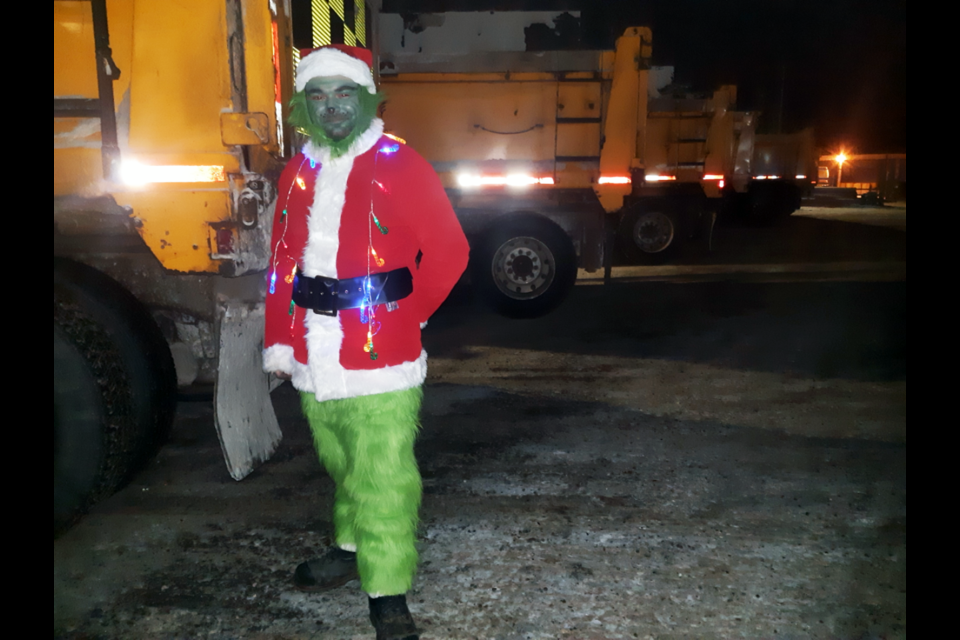City roads foreman Jason Hladchuk wasn’t wearing his usual work attire when he showed up for his nightshift Friday.
He got into the spirit of Christmas, covered his face in green makeup, put on a Santa suit and dressed up like the Grinch.
Looks can be deceiving and he certainly is not a mean boss for the guys and gals who se daily duty is keep our roads clear of snow. But if you’re a driver who chooses to ignore the rules and gets too close to a piece of heavy equipment that’s making our winter roads safe to drive, you might have to deal with an angry Grinch.
The message Hladchuk most wants to get out is for motorists to do whatever they can to avoid coming close to the snow clearing operators. That might mean making a detour or roundabout route to avoid the plough altogether - whatever it takes to make their jobs safer.
“We just want the public to give us space, it’s a 24/7 operation and we just want people to get home, or to or from where they’re going, in winter conditions,” said Hladchuk.
“For the plough trucks, there is limited visibility when they’re ploughing. It all depends on the weather conditions, if its fluffy snow or heavy snow. We ask people not to pass on the right because there’s snow going off of that wing and drivers can’t see, and people still do it.”
He said those illegal passes happen probably twice a day.
Hladchuk used to drive a grader to push the snow off roads and he says its important for drivers to establish eye contact with the operator when approaching a grader or loader, and don’t assume it’s safe to pass. They’re big machines with blind spots and they need a lot of room to turn around. Steep hills can be troublesome for ploughs, which can lose traction and roll backwards and that’s why its important to maintain that 10 metre distance behind them.
By the end of winter, snow piles can get quite high in residential areas. Kids tend to want to build snow caves in those piles but parents should not allow it just because of the danger factor on days when ploughs and loaders are in the area. Drivers are trained, if they see evidence of tunnelling, to stop and get out of their vehicle to check if anybody is inside. Kids can be unpredictable and school zones are avoided by the ploughs during drop-off and pick-up times when there’s more traffic in the area.
The city’s snow-clearing fleet includes eight plough trucks, seven graders, five loaders three sidewalk ploughs, one blower to remove hedgerows and two arrow board trucks. That doesn’t include the dump trucks driven by private contractors who serve the city. Together they operate in three shifts - morning, afternoon and night.
In the bowl part of Prince George, the city uses fracture (crushed rock) as traction material and not sand. That’s due to the health hazard during inversions, when fine particulate gets raised into the atmosphere. The bowl traps that air and it lingers, unlike the Hart and College Heights areas, where the sand is more easily dispersed. Outside of the bowl, sand is the material of choice. Use of rock salt is only permitted on asphalt and it is used in Priority 1 and 2 routes only when the temperatures are right (-7 C or warmer) so it works to melt ice.
All traction materials are sprayed with liquid salt before they are applied. Liquid salt is applied on some higher priority surfaces up to one day before a snowfall to minimize snow accumulations.
Plough trucks dump fracture (rocks) or sand that bounces off the road and people need to stay 10 vehicle lengths away to let the material settle and avoid having their own vehicle bodies pelted by gravel.
“We do turn off our sanders when we meet vehicles and do what we can to make sure we don’t cause damage but we can’t control the vehicles behind us if they’re not giving us the space,” Hladchuk said.
Snow clearing operations are exempt from the city’s noise bylaw.
During the cool-weather months, from Oct 15-April 15, there are parking restrictions in effect in the city which restrict parking at certain hours of the day. On priority routes (main roads) and in the hospital district parking is prohibited from 10 p.m.-7 a.m. On downtown streets, the parking ban goes from midnight-7 a.m. On residential streets there no parking allowed from 8 a.m.-6 p.m.
City council in January approved a $10.2 million budget for snow clearing. The city ploughs 735 kilometres of roads and 200 km of sidewalks . When we get a dump of snow there are three level of priority that determine when those roads get ploughed. A priority map outlines what gets ploughed first.
Priority 1 (red) includes arterial roads, curb adjacent sidewalks, hospital district, downtown business district, major facility entrances, pedestrian surfaces, daily parking areas and off-street city parking lots.
Priority 2 (green) is given to collector roads/sidewalks, priority hills, commercial/industrial roads, laneways and sidewalks, transit bus route that are not Priority 1 and bus stops along Priority 1 routes.
Priority 3 (gray) is for residential roads, laneways and sidewalks, minor facility entrances, pedestrian surfaces and parking areas, park pathways and trails and parking lots and event parking areas (unless it is a major event, which elevates priority).
Go to the city website for more information.



